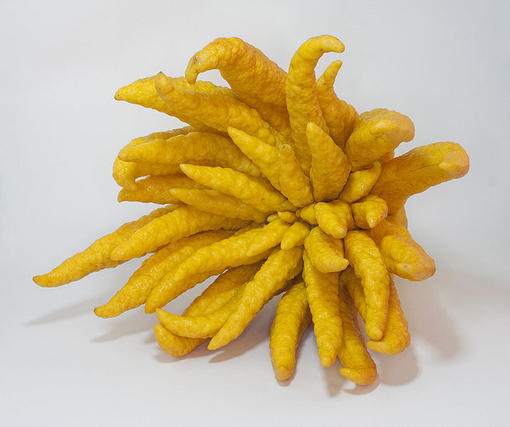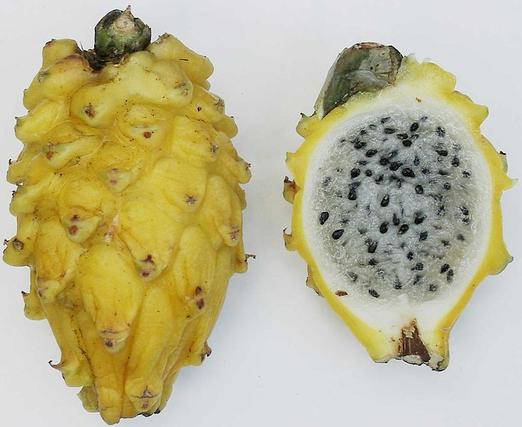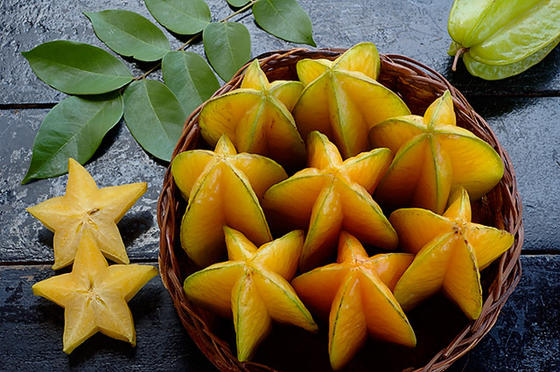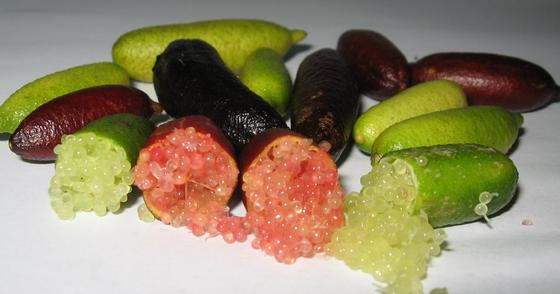 |
| What the ... ? |
SPAIN It is true, many of our readers will be familiar with these fruits, but we have taken the description from the Spanish press - El País, to be exact - in the hope that maybe some of them might appear in local shops, but we doubt it. The descriptions are as closely translated as possible, from an article in the paper's culinary section. The excellent photos are taken from there, too. In some cases we have been unable to find a translation for the actual name of the fruit, so we used the Spanish version (I mean, what's a noni in English, for gawd's sake?)>>>
The article didn't even mention oranges, of which we have riches beyond compare in this area (and long may that last!). In any case, melons, watermelons and even kiwis (which only came into local shops maybe fifteen years ago, and that's because they began to be grown here) we know about. These no longer qualify as exotic, but little by little such delicacies as mangoes, maracuyá (that's passion fruit to you) and even, incredibly for a region that produces citrus by the tons, we can now find grapefruit (pomelo in Spanish) relatively easily.
But every corner of the world offers fruit in a stellar variety of shapes, sizes, tastes and colours - most of them unknown in these parts. So let's look at some of the more extravagant and interesting.
 Pitahaya: Known also as Dragon Fruit, it comes from Central America and is presently grown also in Vietnam, China and Israel. Pink- or yellowish on the outside, the inside is full of little black pips. 90% of the fruit is water, but it is rich in iron, calcium and phosphorous, as well as in Vitamins B, C and E.
Pitahaya: Known also as Dragon Fruit, it comes from Central America and is presently grown also in Vietnam, China and Israel. Pink- or yellowish on the outside, the inside is full of little black pips. 90% of the fruit is water, but it is rich in iron, calcium and phosphorous, as well as in Vitamins B, C and E. Hand of Buddha: This is a citrus fruit that is shaped like a hand. The fruit grows on small bushes or trees with lots of thorns. The skin is thick and it doesn't hold much juice. Its main uses are to perfume a room or to be caramelized in cooking. Its name comes from the fact that it is often used as an offering in Buddhist ceremonies. It is hardly surprising then that it is grown mainly in India and China. We saw one of these on a friends' coffee table on Sunday...
Hand of Buddha: This is a citrus fruit that is shaped like a hand. The fruit grows on small bushes or trees with lots of thorns. The skin is thick and it doesn't hold much juice. Its main uses are to perfume a room or to be caramelized in cooking. Its name comes from the fact that it is often used as an offering in Buddhist ceremonies. It is hardly surprising then that it is grown mainly in India and China. We saw one of these on a friends' coffee table on Sunday... Star Fruit: Relatively well known in the more up market shops, and also called carambola in Spanish, this curious fruit is oval shaped, elongated, with five points that become a five-star when cut. It is only between 7 and 12 cms long, has a thin, edible skin that is yellow/green and orange when ripe. The pulp is crunchy, smooth in texture and glasy to look at. It doesn't have many pips and it tastes bitter-sweet.
Star Fruit: Relatively well known in the more up market shops, and also called carambola in Spanish, this curious fruit is oval shaped, elongated, with five points that become a five-star when cut. It is only between 7 and 12 cms long, has a thin, edible skin that is yellow/green and orange when ripe. The pulp is crunchy, smooth in texture and glasy to look at. It doesn't have many pips and it tastes bitter-sweet.
Noni: Also known as great morinda, Indian mulberry, nunaakai (Tamil Nadu, India) , dog dumpling (Barbados), mengkudu (Indonesia and Malaysia), Kumudu (Balinese), pace (Javanese), beach mulberry, cheese fruit, the Morinda citrifolia or noni is a tree in the coffee family that grows to 8 metres and is widely grown in tropical Asia. The Hawaiians, Samoans and Tahitis have been eating it for centuries for its curative powers, despite its bitter, disagreeable taste and smell. The fruit is about the size of potato, but all parts of the tree can be used: the trunk and roots are used as a dye, for example. However, there are uses that have been forbidden in some countries.

Kiwano: A member of the melon and cucumber family, it is also known as a horned melon or cucumber, jelly melon, hedged gourd, English tomato, melano or cherie, it is considered to be the ancestor of the melon as we know it. It's inedible skin is a vibrant yellow/orange covered in spikes, with a gelatinous greenish pulp and full of pips. About 10 cms long,it weighs about 200 g. It tastes bitter, but is refreshing and similar to the cucumber.
 Lychee: A small oval fruit whose pulp covers a big stone inside. It looks similar to the fruit of a tree strawberry, measuring some 3 or 4 cms. The skin is vibrant red, though sometimes yellow. It tastes sweet and delicious, reminding one of grapes with a touch of rose. It can be bought in tins, often in Chinese shops, though the tinned variety is spreading more widely now. Of course, tinned is not the same as fresh.
Lychee: A small oval fruit whose pulp covers a big stone inside. It looks similar to the fruit of a tree strawberry, measuring some 3 or 4 cms. The skin is vibrant red, though sometimes yellow. It tastes sweet and delicious, reminding one of grapes with a touch of rose. It can be bought in tins, often in Chinese shops, though the tinned variety is spreading more widely now. Of course, tinned is not the same as fresh. Rambután: A native of Southeast Asia, it is now grown all over that continent and in Central America. It is small and oval, with a 'hairy' red, almost purple skin. Inside there is a single hard stone, and the pulp, translucent and gelatinous, tastes like a lychee, sweet and a touch of almond.
Rambután: A native of Southeast Asia, it is now grown all over that continent and in Central America. It is small and oval, with a 'hairy' red, almost purple skin. Inside there is a single hard stone, and the pulp, translucent and gelatinous, tastes like a lychee, sweet and a touch of almond. Kumquat: The smallest of the citrus and the only one whose skin is edible. It comes from East Asia and the tree is often used to decorate a garden or courtyard instead of the more common oranges or lemons. The pulp is divided into 4 or 5 segments with 2 or 3 pips each, depending on the variety. It looks much like a small orange, except for its ovoid shape. The skin is slightly bitter, but sweeter than the pulp, which is more like a lemon.
 Mangosteen: One of the most prized and costly of the exotic fruits (in Spain anyway) for its taste and texture, the fruit is rounded and similar to a chestnut in the skin, which is almost as hard. It is yellowish until it matures, when it turns deep red or purple. Inside, the skin is reddish, the pulp white. It tastes very sweet, sugary, comparable to very ripe plum or grape.
Mangosteen: One of the most prized and costly of the exotic fruits (in Spain anyway) for its taste and texture, the fruit is rounded and similar to a chestnut in the skin, which is almost as hard. It is yellowish until it matures, when it turns deep red or purple. Inside, the skin is reddish, the pulp white. It tastes very sweet, sugary, comparable to very ripe plum or grape. Fingerlimes: Grown principally in Australia, this fruit is of the citrus family. It grows slowly to a height of between three and five meters, giving fruit only after several years. Grafting appropriately, it is a viable commercial crop. It tastes much like a conventional lime but the texture reminds one of a pomegranate.
Fingerlimes: Grown principally in Australia, this fruit is of the citrus family. It grows slowly to a height of between three and five meters, giving fruit only after several years. Grafting appropriately, it is a viable commercial crop. It tastes much like a conventional lime but the texture reminds one of a pomegranate.And here's one we prepared earlier. We saw it in the bar across the road, photoed it and returned it to its place only after a loud argument about what the locals were calling it: patata. It is not a potato, but we have been unable to identify it and it will probably rot before we can see the the inside. The skin is white and waxy - can anyone identify it?
IF YOU FIND THIS ARTICLE INTERESTING, USEFUL OR ENTERTAINING, PLEASE CONSIDER THE WORK, EFFORT AND COST IT TAKES TO BRING IT TO YOU. WE WOULD APPRECIATE A DONATION TO CONTINUE A FREE SERVICE.




No comments:
Post a Comment